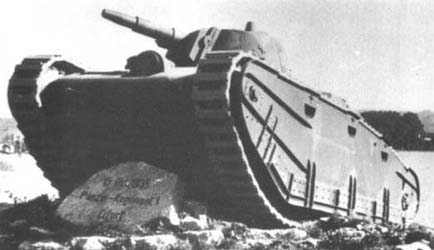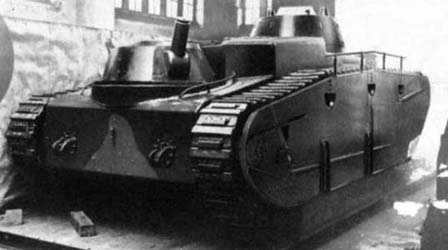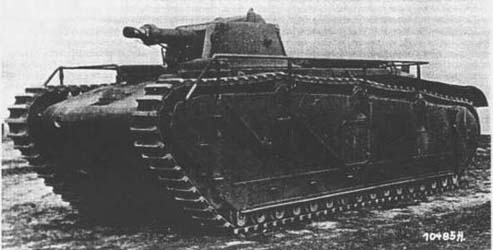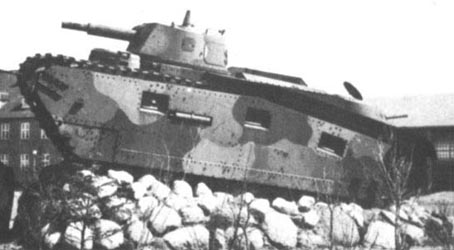/Vehicles/Axis/Germany/03-sPanzers/Grosstraktor/File/Grosstraktor.htm | Last Up-date: -
Grosstraktor Heavy Tank
Grosstraktor I (Daimler-Benz)
En 1925, Rheinmetall-Borsig, Daimler-Benz et Krupp reçurent l'ordre de concevoir des chars moyens/lourds nommés "Armeewagen 20" (voiture militaire 20). Ces modèles devaient être longs de 6.0 m, larges de 2.4 m, et armés du canon de 75 mm monté dans une tourelle tournante et peser dans les 15 tonnes. Chaque firme devait produire deux prototypes en acier doux (6-14mm) sous le couvert de véhicules utilitaires. Krupp produisit une propre tourelle pour son propre design, alors que Rheinmetall concevait une tourelle pour son usage et celui de Daimler-Benz.
In 1925, Rheinmetall-Borsig, Daimler-Benz and Krupp accepted the order to design medium/heavy tanks named "Armeewagen 20" (military car 20). These models were to be long 6.0 m, broad 2.4 m, and armed with the gun of 75 mm assembled in a revolving turret and to weigh in the 15 tons. Each firm was to produce two mild steel prototypes (6-14 mm) under cover of commercial vehicles. Krupp produced a proper turret for its own design, whereas Rheinmetall designed a turret for its use and that of Daimler-Benz.
 |
 |
Grosstraktor I |
|
src: Site "Achtung
Panzer" |
src: Site "Achtung
Panzer" |
Le travail débuta en 1925 et des essais furent projetés pour 1929-1930. Le Grosstraktor de Daimler-Benz fut dessiné par le Dr.Porsche et était armé du canon de 75mm KwK L/24 monté dans une tourelle centrale et de 3-4 mitrailleuses de 7.92 mm montées dans de petites tourelles. Ce char, il faut le noter, possédait des aptitudes amphibies et était propulsé par un 6 cylindres (essence) Daimler M182206 développant 255-260 cv. Sa suspension était plutôt sophistiquée avec des ressorts lame. Seulement deux prototypes en acier doux furent complétés en 1929 et 1930 et furent testés dans le plus grand secret. Ces prototypes connurent des problèmes de transmission, ce qui annula tout développement ultérieur. L'un des deux fut réarmé avec une version allongé du canon de 75mm.
Work began in 1925 and of tests were projected for 1929-1930. Grosstraktor of Daimler-Benz was drawn by Dr.Porsche and was armed with the gun of 75mm KwK L/24 assembled in a central turret and of 3-4 machine-guns of 7.92 mm assembled in small turrets. This tank, it should be noted, had amphibians performances and was propelled by one 6 cylinders (gasoline) Daimler M182206 developing 255-260 hp. Its suspension was rather sophisticated with blade springs. Only two mild steel prototypes were supplemented in 1929 and 1930 and were tested in the greatest secrecy. These prototypes knew problems of transmission, which cancelled any later development. One of both was rearmed with a lengthened version of the gun of 75mm.
75
mm KwK 37 L/24 Penetration of a shielding plate (mm) under a plunging angle of 30° |
|||||||
Ammo |
Weight |
Velocity |
100
m |
500 m |
1000
m |
1500 m |
2000
m |
| K Gr rot Pz | 6.8 kg |
385 m/s |
41 |
39 |
35 |
33 |
30 |
| Gr 38 H1/A | 4.4 kg |
450 m/s |
70 |
39 |
35 |
33 |
30 |
| Gr 38 H1/B | 4.57 kg |
450 m/s |
75 |
39 |
35 |
33 |
30 |
Gr 38 H1/C |
4.80 kg |
450 m/s |
100 |
39 |
35 |
33 |
30 |
| General |
Type:
Heavy Tank |
| Engine |
| BMW Va (6-cyl. gasoline) | 300 hp |
| Dimensions/Masses |
| Length: 6.65 m
| Width: 2.81 m | Height:
2.45 m Weight: 19320 kg |
| Armor |
| Maximum: 14 mm |
| Performances |
| Max. Speed:
40 km/h | Power/weight: 15.5 hp/t
| Range: 150 km Suspension: Leaf spring |
| Armament |
Main:
75 mm KwK L/24 (104) |
Drawings |
Grosstraktor II (Rheinmetall-Borsig)
Le Grosstraktor II fut développé par Rheinmetall-Borsig et était armé du canon de 75mm KwK L/24 et de trois mitrailleuses de 7.92 mm. De conception plus simple que le Grosstraktor I, il possédait en outre des portes d'accès latérales et aussi des possibilités amphibies. Seulement deux prototypes ont été produits en 1928 puis en 1929. Ils furent par après modifiés en 1930, 1932 et 1933. Le Grosstraktor était propulsé par un 6 cylindres BMW Va développant 250 cv.
Grosstraktor II was developed by Rheinmetall-Borsig and was armed with the gun of 75mm KwK L/24 and of three machine-guns of 7.92 mm. With a design simpler than Grosstraktor I, it had moreover side access doors and also amphibians possibility. Only two prototypes were produced in 1928 then in 1929. They by after were modified in 1930, 1932 and 1933. Grosstraktor was propelled by one 6 cylinders BMW Va developing 250 hp.
 |
Grosstraktor II |
src: Site MTG
|
| General |
Type:
Heavy Tank |
| Engine |
| BMW Va (6-cyl. gasoline) | 300 hp |
| Dimensions/Masses |
| Length: 6.65 m
| Width: 2.81 m | Height:
2.45 m Weight: 19320 kg |
| Armor |
| Maximum: 14 mm |
| Performances |
| Max. Speed:
40 km/h | Power/weight: 15.5 hp/t
| Range: 150 km Suspension: Leaf spring |
| Armament |
Main:
75 mm KwK L/24 (104) |
Drawings |
Grosstraktor III (Krupp)
Le Grosstraktor III conçu par Krupp était très semblable aux autres conceptions mais possédaient beaucoup de différences de détail. Deux prototypes seulement furent produits, en 1928 et en 1929 et furent tous deux modifiés en 1931. La suspension était munie de ressorts hélicoïdaux.
Grosstraktor III conceived by Krupp was very similar to the other designs but had many differences in detail. Two prototypes only were produced, in 1928 and 1929 and were both modified in 1931. The suspension was provided with helical springs.
 |
Grosstraktor III |
src: Site "Achtung
Panzer"
|
Les Grosstraktors avait un poids d'environ 16 tonnes et vitesse maximum de 40-44 km/h. Aucun de ces prototypes en raison de nombreux problèmes et défauts n'entra en production. En 1933, après la fin de la coopération germano-soviétique, les prorotypes retournèrent en Allemagne. Ceux de Krupp et Rheinmetall-Borsig furent employés pour la formation. Par la suite, ils furent versés dans la 1re Pz-Division et participèrent aux manoeuvres d'août 1935. Les prototypes de Daimler-Benz finirent comme monuments aux quartiers-généraux du 1er Pz-Rgt à Erfurt et du 5e Pz-Rgt à Wundsdorf. Après 1935, les prototypes furent employés pour la formation. En 1937, un prototype de Krupp ou de Rheinmetall fini comme monument au quartier-général du 5e Pz-Rgt à Wunsdorf. Les deux restants furent ferraillés ou employés comme cible lors d'exercices.
Grosstraktors had a weight approximately of 16 tons and maximum speed of 40-44 km/h. None of these prototypes because of many problems and defects did not start production. In 1933, after the end of the germano-Soviet co-operation, the prorotypes turned over to Germany. Those of Krupp and Rheinmetall-Borsig were employed for the formation. Thereafter, they were versed in the 1st Pz-Division and took part in the training operations of August 1935. The prototypes of Daimler-Benz finished like monuments with the head-quarters of 1st Pz-Rgt at Erfurt and 5th Pz-Rgt at Wundsdorf. After 1935, the prototypes were used for the formation. In 1937, a prototype of Krupp or Rheinmetall finished like monument at the head-quarter of 5th Pz-Rgt at Wunsdorf. The two remainders were reinforced or employed like target at the time of exercises.
| General |
Type:
Heavy Tank |
| Engine |
| BMW Va (6-cyl. gasoline) | 300 hp |
| Dimensions/Masses |
| Length: 6.65 m
| Width: 2.81 m | Height:
2.45 m Weight: 19320 kg |
| Armor |
| Maximum: 14 mm |
| Performances |
| Max. Speed:
40 km/h | Power/weight: 15.5 hp/t
| Range: 150 km Suspension: Leaf spring |
| Armament |
Main:
75 mm KwK L/24 (104) |
Drawings |
Sources:
- Site "Achtung Panzer" - http://www.achtungpanzer.com
TNT HS n°1